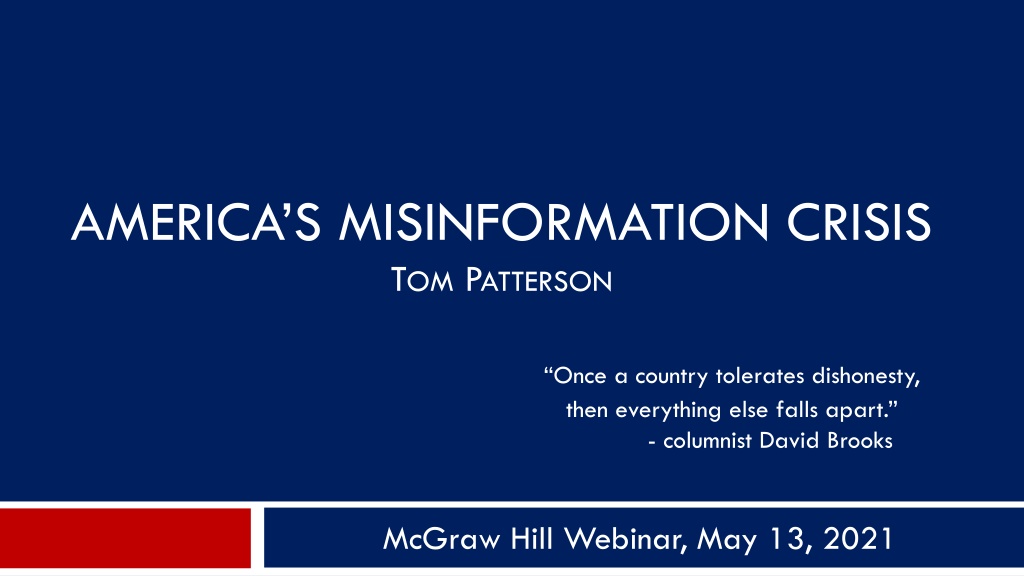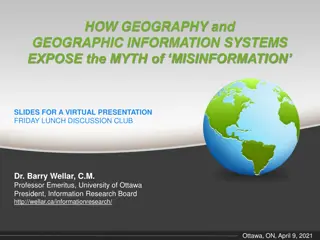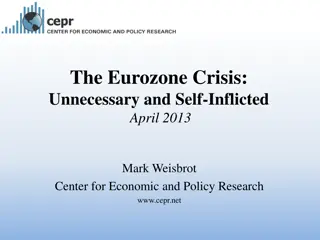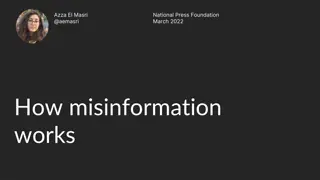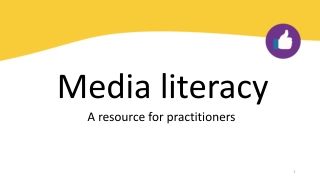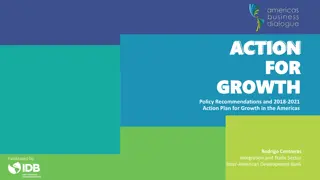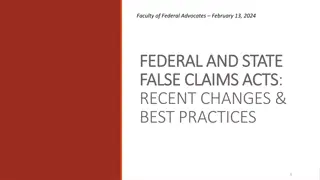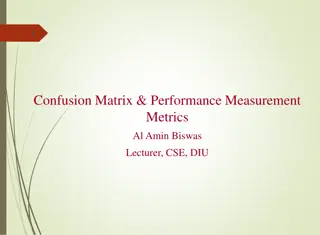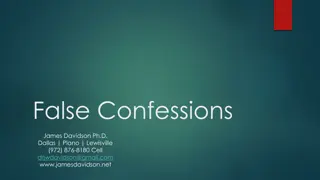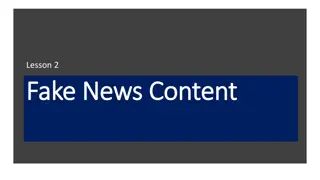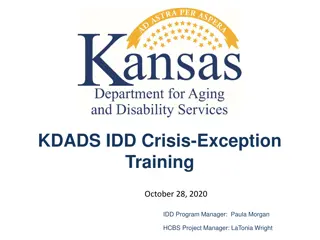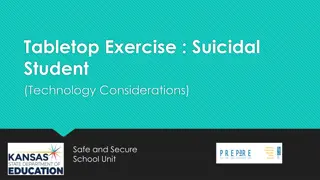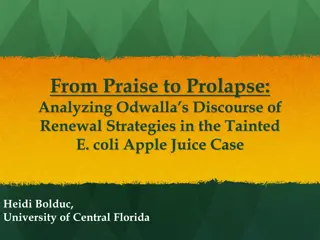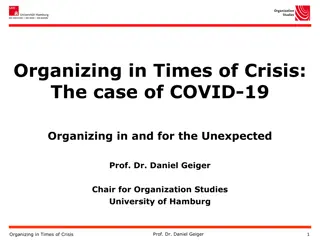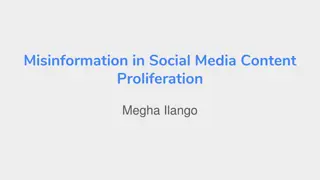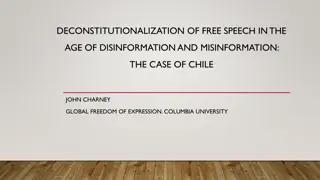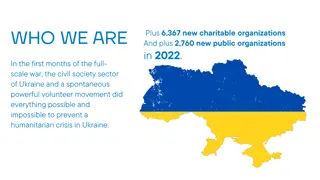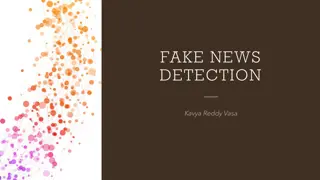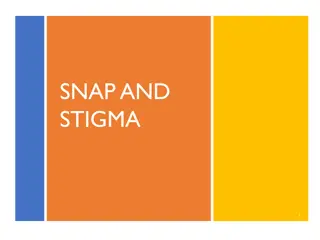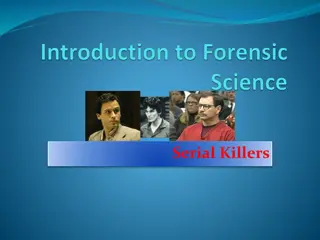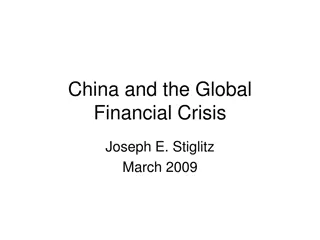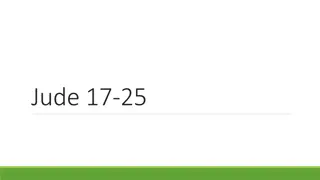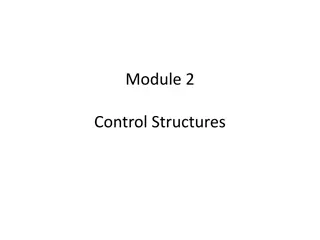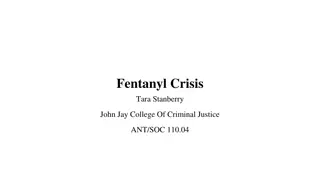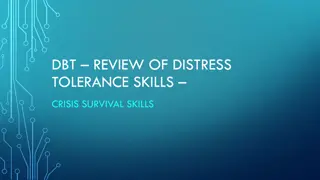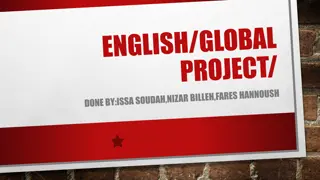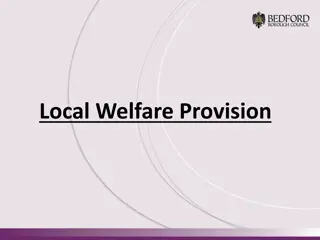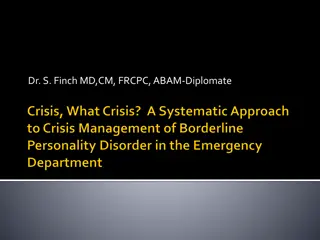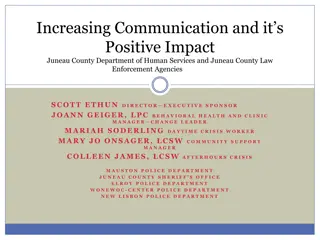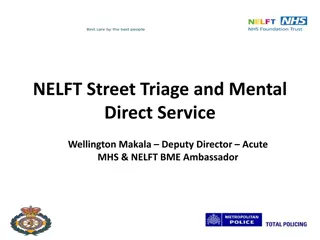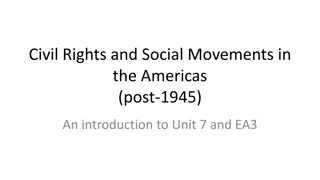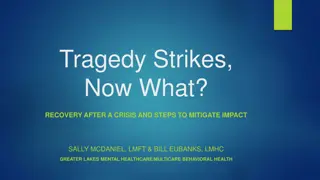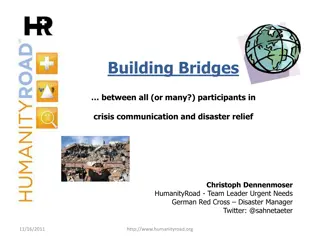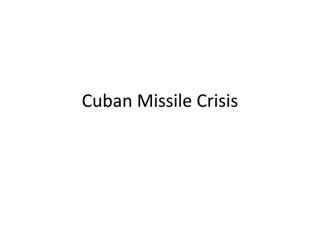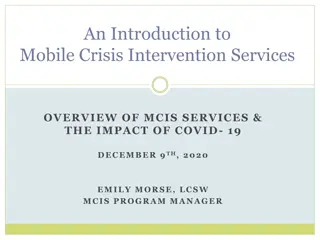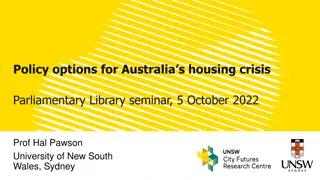America's Misinformation Crisis: The Chilling Impact of False Information on Society
Misinformation and disinformation pose significant threats to society, as highlighted by columnist David Brooks and Tom Patterson. The increase in false information is fueled by party polarization, social media, and a breakdown of norms. Public misperceptions and false beliefs are rampant, with examples of recent factual claims reflecting the severity of the issue. This information crisis demands urgent attention to safeguard the integrity of public discourse and decision-making.
Download Presentation

Please find below an Image/Link to download the presentation.
The content on the website is provided AS IS for your information and personal use only. It may not be sold, licensed, or shared on other websites without obtaining consent from the author. Download presentation by click this link. If you encounter any issues during the download, it is possible that the publisher has removed the file from their server.
E N D
Presentation Transcript
AMERICAS MISINFORMATION CRISIS TOM PATTERSON Once a country tolerates dishonesty, then everything else falls apart. - columnist David Brooks McGraw Hill Webinar, May 13, 2021
Definitions Misinformation: False information that is held or spread, regardless of intent. Disinformation: False information that is spread with the intent to mislead.
An Old Problem Harper s, October 1925
But conditions have changed Demand Side: Although human psychology hasn t changed, party polarization has heightened demand for misinformation & our response to it Supply-side: Rise of partisan and social media and breakdown of norms against lying have resulted in a dramatic increase in the supply of misinformation
Level of Public Misinformation (Estimated) percentage of citizens misinformed on typical major issue 40 35 37 33 33 30 2830 25 23 20 19 15 17 14 10 5 0 1980 1985 1990 1995 2000 2005 2010 2015 2020 Note: Ballpark estimates by author based on opinion poll questions.
Americans Hold a Lot of False Beliefs Index of Public Misperceptions About Politics and Society Based on responses to 28 factual questions Sweden Germany South Korea Japan Great Britain Poland Spain Canada Belgium Australia France USA Italy 0 20 40 60 80 100 Source: IPSOS Survey, 2017
Examples of recent factual claims Donald Trump faked having Covid-19 in order to win sympathy votes Joe Biden is mentally impaired Dr. Anthony Fauci funded a lab in Wuhan to develop the coronavirus If reelected, Donald Trump planned to eliminate social security and Medicare Kamala Harris was not born in United States CDC manipulated numbers to exaggerate number of dead from Covid-19 President Trump went to the hospital last year after suffering a stroke Vote counting machines overcounted the Biden vote
None are true, but each is believed by tens of millions of Americans percentage of respondents saying statement is true Trump cut soc sec 48 Biden mentally impaired 45 Vote machines rigged 43 CDC faked Covid 42 Trump faked Covid 41 Trump had stroke 31 Fauci funded Wuhan 27 Harris not a citizen 27 Source: Indiana University s Observatory on Social Media survey, November 2020
Impact of Misinformation Assault on Capitol 585,000 deaths from Covid
The events were fueled by misinformation millions of Americans refused to accept the facts percentage of respondents Election was stolen from Donald Trump Republicans 68 Democrats 10 Is it very important for people to wear a mask when in public? Yes 48 No/Don't know 52 Sources: Gallup poll, May 2020, for Covid; Fox News poll, Dec 2020, for election
COVID 19c Misinformation led to biggest public health failure in our history The United States should have been a world leader in reducing fatalities from Covid-19 Per capita, US has the most ICU units and hospital beds Yet on deaths per capita, US ranks 165thout of the world s 177 countries for which there are data If US had EU death rate roughly 100,000 fewer deaths If US had Canada s death rate roughly 350,000 fewer deaths Source: Johns Hopkins/World Bank data set.
Explaining the Rise of Misinformation Party Polarization
The widening partisan divide Ideological position of median voter Conservative median Republican median Democrat Liberal 1994 2011 2017 Source: Derived from Pew Research Center s poll naalysis
Perception of those in other party percentage of respondents How Republicans see Democrats "enemies" 57 "opponents" 43 How Democrats see Republicans "enemies" 41 "opponents" 59 Source: CBS News poll, February, 2021
Why Polarization Matters Party polarization heightens: Cue-taking Our tendency to accept at face value claims made by our party leaders and by like-minded media sources Confirmation Bias: Our psychological tendency to interpret claims in ways that fit our partisan beliefs and biases.
Confirmation Bias Accepting false claims that align with one s partisanship 57 Trump faked Covid 17 47 Trump had stroke 16 Democrats Republicans 46 Trump cut soc sec 6 19 Fauci paid Wuhan 34 12 Harris not citizen 38 19 CDC faked Covid 54 Vote machines rigged 23 76 Biden mentally impaired 22 82 Source: Indiana University s Observatory on Social Media survey, November 2020
Explaining Our Misinformation Crises Changes in Media System
The Old Low-Choice Media System (pre-1980) Size of daily audience (viewers/subscribers) network evening news 55,000,000 63,000,000 daily newspaper
Consequences of Low-Choice System 1. An information commons 2. Rising level of information 3. Depolarization
Todays High-Choice System: Elimination of Fairness Doctrine Fairness Doctrine required broadcast licensees to treat opposing sides fairly and to include public affairs programming In 1987, the Fairness Doctrine was eliminated, giving station owners freedom to air programming of their choosing. Resulting developments: Reduction in number of stations that aired news on hour Increase in number of stations carrying partisan talk shows
Effect of Eliminating Fairness Doctrine: Size of Weekly Political Talk Show Audience Audience (in millions) 43 32 12 5 1985 1990 1995 2000
Audience Share of Partisan Talk Shows (weekly Arbitron ratings) percentage of total audience conservative host 91 liberal host 9 Source: Arbitron, March 2021
The High Choice Media System Emergence of Cable TV Percentage of homes with cable/satellite 80 53 20 1980 1990 2000
Partisan News Comes to Cable Fox (1996) Rubert Murdoch starts Fox News as a conservative alternative, hiring Republican political consultant Roger Ailes to run it MSNBC (2005) Started in 1996 as a competitor to CNN, shifted in 2005 to become liberal alternative to Fox CNN (2013) Changes format by adding liberal-leaning talk shows to its lineup
Partisan Sorting: Cable News Audience percentage of partisans who say outlet is a main source of news 6 Fox 93 79 CNN 17 95 MSNBC 5 Democrats Republicans Source: Pew Research Center poll, 2019
The High Choice System Internet Top 25 political blogs Liberal 13 Conservative 11 Moderate 1 Source: Feedspot, 2021
Blogs as Echo Chambers Nearly all political blogs and websites are ideological and unwelcoming to those who hold diverse opinions. Over 90 percent of links on political blogs/websites link to sites that cater to the same beliefs.
The High Choice System Social Media percentage of respondents who respond favorably to a political tweet depending on whether it s supportive of their partisanship Republicans Supporitve 15 Unsupportive 5 Democrats Supportive 15 Unsupportive 5 Source: David Rand, et al, Shared Partisanship Dramatically Increases Social Tie Formation in a Twitter Field Experiment, Proceedings of the National Academy of Sciences, 2021.
High Choice System vs. Low-Choice System Why the change matters
Sources of Misinformation Partisan Media Partisan talk shows/websites are filled with disinformation Based on a study of more than four million media messages, Yochai Benchler et al concluded that partisan media are distinctive for their disinformation, lies, and half-truths. Sources: Benchler, et al, Network Propaganda; New York Times, November 13, 2020 (based on MIT s RadioSpeak data)
Talk Shows and Disinformation Covid 19 Example It s no worse than the common cold, folks, Rush Limbaugh It s a great time to fly. Laura Ingraham Healthy people, generally, 99 percent recover very fast, even if they contract it. . . Put it in perspective: 26 people were shot in Chicago alone over the weekend. You notice there s no widespread hysteria about violence in Chicago. Sean Hannity
Conservative talk-show viewers/listeners perception of pandemic percentage of conservative talk show listeners/viewers Has the pandemic been made out to be a bigger deal than it actually is? yes 78 no 3 Source: Pew Research Center survey, September 2020.
Fake news sharing dominated by a few super-sharers 5,503 out of 95,660 (5.8%) Twitter links in one study were to fake news in 2016 4,790 users (of 22K) shared at least 1 political URL Of those, 7% (348) shared a fake news URL 70% of fake news was shared by a set of 15 people! Source: Grinberg et al. (2019)
Impact of Fake News (2016 Election) Percentage of respondents seeing story who believe it s true Suspect in Hillary email leak dead in murder-suicide 22 72 percent said they saw Hillary story; 69 percent said they saw Pope Francis sotry Pope Francis endorsed Donald Trump 19 Source: Ispos poll, Nov-Dec 2016.
The Power of Fake to Attract Our Attention relative speed with which a story travels on social media. Actual news story 1.00 On average, fake stories travel six times faster on social media than true stories Fake news story 6.00 Source: Soroush Vosoughi, Deb Roy, and Sinan Aral, The spread of true and false news online, Science 369 (2018): 1146-1151.
Contributing to the problem- our flight from reliable news sources 22,000,000 daily network news audience 26,000,000 daily newspaper circulation Accurate information counters misinformation but only if you have it.
Also, traditional news sources are not as reliable as they once were News organizations play a major role in propagating hoaxes, false claims, questionable rumors, and dubious viral content. Craig Silverman, et al, Lies, Damn Lies and Viral Content, Columbia University, February 10, 2015. Although traditional news outlets don t typically twist the facts, they report the words of political leaders who do shade the truth over 80 percent of false claims are disseminated without mention that they re inaccurate.
The News Media and Trump s Tweets A NY Times fact check found that a third of Trump s tweets contained a significant falsehood. How did Americans learn of Trump s tweets? 1% directly from his Twitter feed 99% directly or indirectly through the media Sources: Fact check, https://www.nytimes.com/2020/06/03/us/politics/trump-twitter-fact-check.html; tweet exposure, http://www.newsweek.com/trump-tweets-one-percent-mainstream-media-769207
Lying and Political Leaders Deception at the highest levels of government is not new e.g., Pentagon Papers But the norm against lying by political leaders has weakened Lying is now endemic at the highest levels of our politics [Misinformation is highest for issues on which elites prominently and persistently [make] incorrect claims. Josh Pasek, et, Journal of Communication, 2015.
Elite-Driven Disinformation Example Does the Affordable Care Act include "death panels"? Yes 41 No 52 Not sure 7 Source: Associated Press-GfK survey, 2012
Misinformation Effect Covid Vaccine percentage who say that have not/will not take vaccine Republicans 36 Democrats 12
Fixing our misinformation problem We could hold political leaders to account for lying BUT:We don t detect it when our side s leaders say it, and we don t value truth enough to base our vote on it. We could get our information from reliable sources BUT: Many of us prefer sources that tell us what we want to believe there s high demand for confirming information. We could hold ourselves to a higher standard BUT: Confirmation bias is ingrained we don t know when we re wrong and tend to reject conflicting information.
Fixing our misinformation problem 1. Fact checking studies don t show it to be all that effective and might contribute to spread of misinformation in some instances 2. Media literacy courses the effect might be short lived 3. Platform intervention (removing false claims, delisting serial abusers, noting that a story is suspect) most promising but more research on efficacy is needed.
Fixing our misinformation problem Breaking the hold of party polarization on our politics If history is a guide, that will only happen when one of our parties becomes much stronger than the other.
Thank you Questions, Observations, Objections
